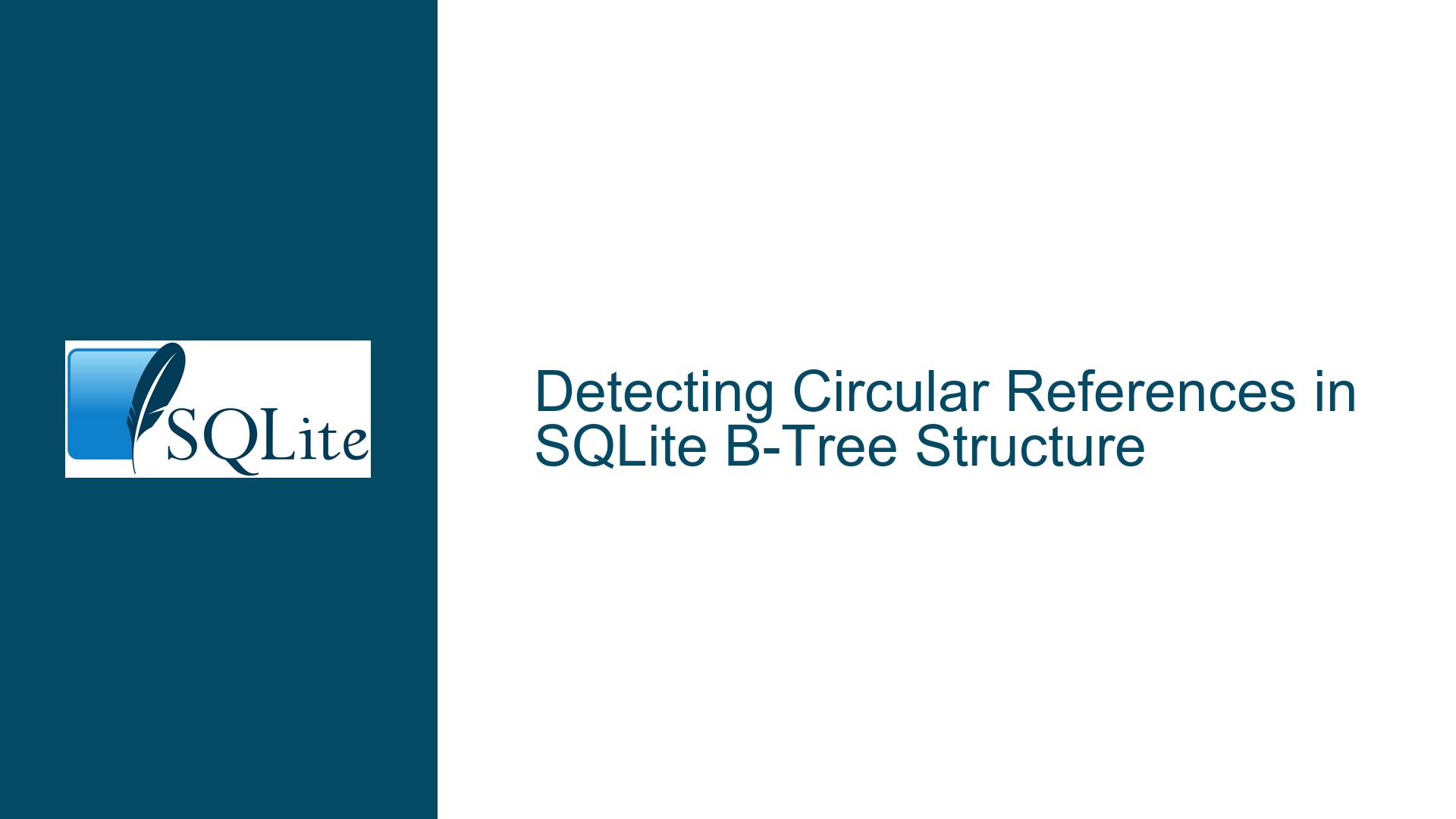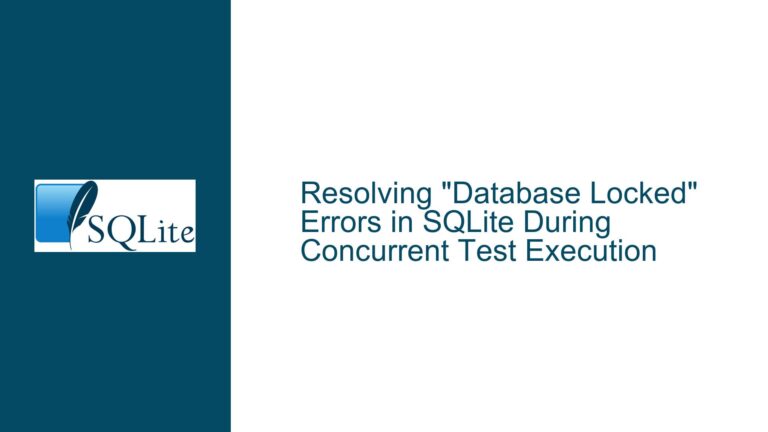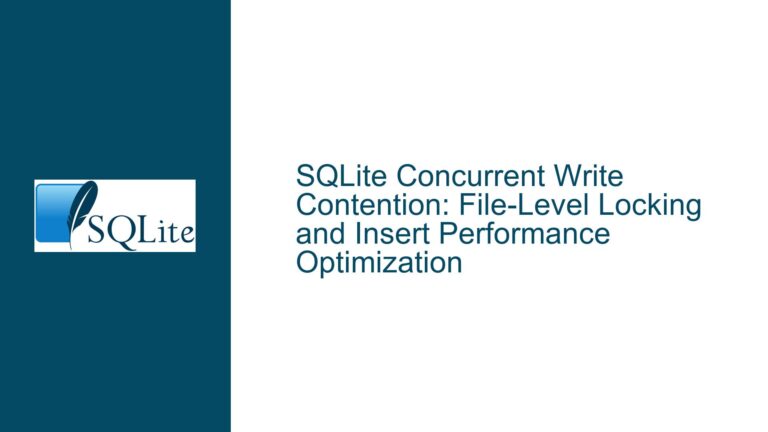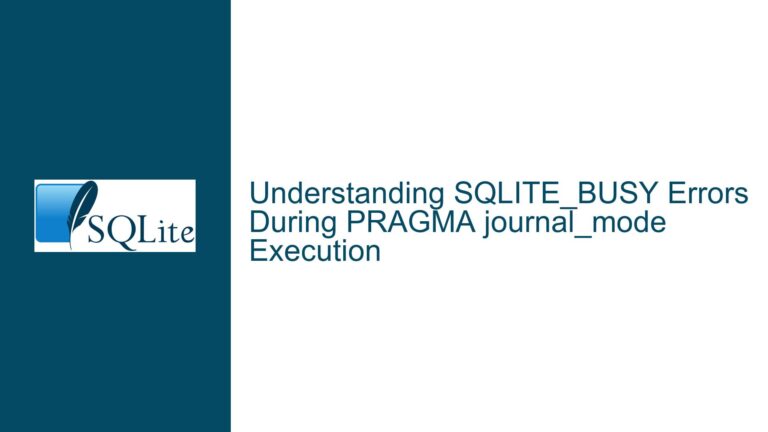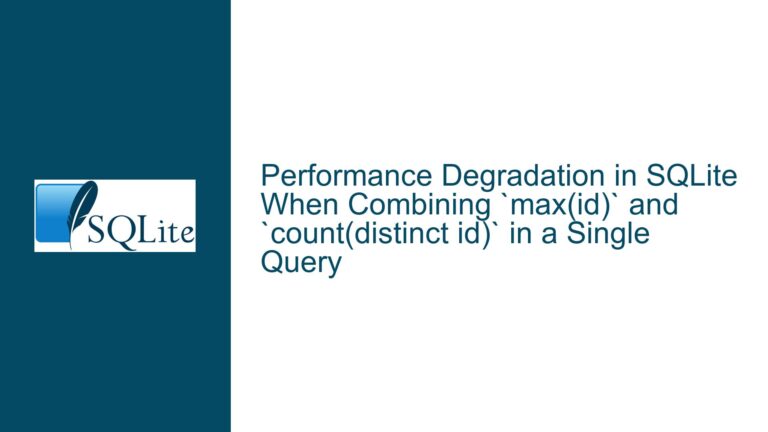Detecting Circular References in SQLite B-Tree Structure
Understanding Circular References in B-Tree Structures
In the context of SQLite, a B-Tree (Balanced Tree) structure is crucial for managing data efficiently. It serves as the underlying structure for tables and indexes, allowing for fast retrieval and storage of data. However, one of the significant challenges that can arise when dealing with B-Trees is the detection of circular references, which can lead to infinite loops during data traversal.
A circular reference occurs when a node in the B-Tree points back to itself either directly or indirectly through a series of child nodes. This situation can create an endless loop when traversing the tree, as the traversal algorithm may continuously follow the references without reaching a termination point. The implications of such an issue are severe, as they can lead to application crashes, unresponsive systems, or corrupted databases.
The original query posed by a user in the forum highlights the need for a reliable method to detect whether the "page number of the left child" refers back to its parent page or any ancestor page. The user expresses difficulty in locating the relevant section of SQLite’s source code that handles this detection and seeks insights on how to approach this problem.
SQLite does incorporate mechanisms to manage B-Tree structures effectively; however, understanding how these mechanisms work requires a deeper dive into its internal operations. The discussion reveals that while SQLite does not explicitly check for circular references at every step, it does have safeguards against excessive recursion that can be indicative of such issues.
One key point raised in the discussion is related to the depth of the B-Tree. The depth is inherently limited by the maximum database size and is influenced by factors such as fanout—the number of children each node can have. A higher fanout generally leads to shallower trees, which can help mitigate the risk of deep recursion and potential circular references.
The conversation also touches upon what constitutes a "sane limit" for B-Tree depth. Dan Kennedy notes that while SQLite uses an internal depth limit of 20, practical limits may vary based on database design and usage patterns. For instance, he mentions that a minimum fanout of 4 for index B-Trees allows for a maximum depth capable of accommodating up to $$2^{32}$$ pages under worst-case conditions.
Understanding these parameters is essential for developers working with SQLite databases, especially those who are optimizing performance or debugging issues related to data retrieval and storage. By maintaining awareness of how B-Tree structures function and their limitations, developers can better design their schemas and queries to avoid pitfalls associated with circular references.
In summary, detecting circular references within SQLite’s B-Tree structures is not straightforward but involves understanding both the theoretical aspects of tree structures and practical implementation details within SQLite itself. The discussion underscores the importance of recognizing potential issues early in database design and implementation phases, allowing developers to implement preventive measures or debug effectively when problems arise.
Identifying Circular References in B-Tree Structures
Circular references in B-Tree structures can lead to significant issues in database management, particularly in systems like SQLite where data integrity and efficient retrieval are paramount. Understanding the potential causes of these circular references is crucial for developers and database administrators to prevent them from occurring and to ensure the stability of their database systems.
Understanding Circular References
A circular reference occurs when a node in a B-Tree indirectly or directly points back to itself. This situation can create infinite loops during traversal operations, leading to application crashes or unresponsive behavior. In the context of SQLite, where B-Trees are used extensively for indexing and data storage, such references can severely impact performance and reliability.
Key Causes of Circular References
Improper Node Linking: One of the primary causes of circular references is improper linking between nodes. When a child node is incorrectly set to point back to its parent or another ancestor node, it creates a loop that can be traversed indefinitely.
Recursive Relationships: In some database designs, recursive relationships may be necessary. For example, an entity may need to reference itself for versioning or hierarchical purposes. If not managed correctly, these relationships can lead to circular references.
Foreign Key Constraints: Circular foreign key constraints between tables can also result in circular references within B-Trees. When two tables reference each other through foreign keys without a clear hierarchy or without deferring constraints, it can cause issues during data insertion and updates.
Excessive Depth: B-Trees are designed to maintain a balanced structure with limited depth. However, if the tree grows too deep due to improper balancing or excessive data insertion without appropriate splits, it can lead to situations where nodes may inadvertently reference back up the tree.
Faulty Data Migration: During data migration processes, if the relationships between entities are not carefully preserved or re-established, it can lead to unintended circular references. This is particularly critical when migrating from one database system to another or when restructuring existing data.
User Error in Schema Design: Often, circular references can stem from user error during schema design. Developers might create relationships without fully considering the implications of those relationships on the overall data structure.
Implications of Circular References
The presence of circular references within B-Trees has several implications:
Performance Issues: Circular references can lead to performance degradation as traversal algorithms may enter infinite loops, consuming resources and leading to application timeouts.
Data Integrity Risks: When circular references exist, maintaining data integrity becomes challenging. Operations that rely on traversing the tree may yield inconsistent results or fail altogether.
Complex Debugging: Identifying and resolving circular references can be complex and time-consuming. Debugging tools may struggle to pinpoint the source of the issue when loops exist within the tree structure.
Increased Maintenance Overhead: Databases with circular references require more maintenance as developers must constantly monitor for potential issues arising from these loops, adding overhead to database management tasks.
Conclusion
Circular references in B-Tree structures present significant challenges that can impact both performance and data integrity within SQLite databases. By understanding the key causes of these issues—ranging from improper node linking and recursive relationships to foreign key constraints—developers and database administrators can take proactive steps to design their schemas more effectively and implement strategies that minimize the risk of encountering circular references. Addressing these concerns early in the design process is essential for ensuring a stable and efficient database environment.
Effective Strategies for Detecting and Preventing Circular References in B-Tree Structures
To effectively manage circular references within B-Tree structures in SQLite, developers must implement a variety of strategies that focus on detection, prevention, and resolution of potential issues. These strategies can help maintain data integrity and ensure that the database operates efficiently without encountering infinite loops or other related problems.
Implementing Detection Mechanisms
Detection of circular references is a critical first step in managing B-Tree structures. Several methods can be employed to identify potential circular references before they cause significant issues:
Depth-First Search (DFS): One effective way to detect circular references is to implement a depth-first search algorithm. By traversing the B-Tree and maintaining a record of visited nodes, developers can check if a node is revisited during traversal. If a node appears more than once in the path, a circular reference exists. This method is particularly useful for trees with complex relationships.
Tracking Ancestors: Another approach involves tracking the ancestors of each node as it is being processed. By maintaining a stack or list of ancestor nodes, developers can check if the current node being processed is already present in the ancestor list. If it is found, this indicates a circular reference.
Using Recursive Common Table Expressions (CTEs): In SQL databases that support recursive queries, such as SQLite, developers can utilize recursive CTEs to traverse the tree structure while checking for cycles. By counting the number of nodes visited and comparing it to the total number of unique nodes, it becomes possible to identify cycles.
Custom Functions: Developers can create custom functions that check for circular references during insert or update operations. These functions can be triggered automatically whenever changes are made to the database schema or data, providing real-time detection.
Prevention Techniques
While detection is essential, preventing circular references from occurring in the first place is even more critical. Several best practices can be followed to minimize the risk:
Schema Design Considerations: Thoughtful schema design is crucial in preventing circular references. Developers should carefully analyze relationships between tables and ensure that foreign key constraints do not create loops. For example, when designing hierarchical data structures, consider using single-parent relationships where possible.
Foreign Key Constraints: Use foreign key constraints judiciously to enforce referential integrity while avoiding circular dependencies. In cases where circular references are necessary, consider deferring constraints until after all related records have been inserted.
Path Storage Techniques: For tree structures implemented using adjacency lists, storing paths as strings can help prevent circular references. By ensuring that no node’s path includes its own ID during insertions or updates, developers can avoid creating loops.
Triggers for Validation: Implement triggers that validate incoming data against existing structures before allowing inserts or updates. These triggers can enforce rules that prevent circular references by rolling back transactions if violations are detected.
Limit Depth and Fanout: By limiting the depth of B-Trees and ensuring a reasonable fanout (the number of children per node), developers can reduce the likelihood of deep recursion leading to circular references.
Resolving Circular References
In cases where circular references are detected after they have been established, resolving these issues promptly is essential:
Data Cleanup Procedures: Implement cleanup procedures that regularly check for and resolve circular references within the database. This may involve identifying problematic nodes and restructuring their relationships to eliminate loops.
Manual Intervention: In some instances, manual intervention may be necessary to resolve complex circular references. Database administrators should be prepared to analyze relationships and make adjustments as needed.
Error Handling Mechanisms: Ensure robust error handling mechanisms are in place to manage situations where circular references cause operations to fail. Providing clear error messages and rollback capabilities can help maintain user trust and system stability.
Documentation and Training: Educate development teams about the risks associated with circular references and provide documentation outlining best practices for database design and management.
Conclusion
Managing circular references within B-Tree structures in SQLite requires a comprehensive approach that encompasses detection, prevention, and resolution strategies. By implementing effective detection mechanisms such as depth-first search and ancestor tracking, developers can identify potential issues early on. Preventive measures such as thoughtful schema design and robust foreign key constraints play a vital role in minimizing risks.
When faced with existing circular references, prompt resolution through data cleanup procedures and manual intervention ensures database integrity remains intact. Ultimately, fostering an understanding of these challenges among development teams will lead to more resilient database designs capable of supporting complex data relationships without succumbing to the pitfalls of circularity.
